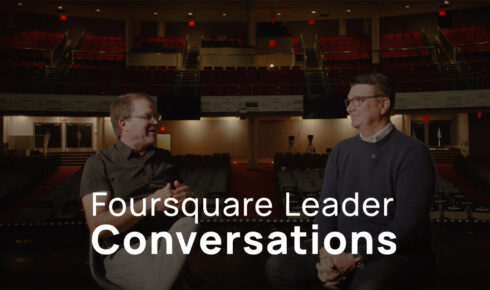Fifteen hundred participants later and I’m still learning about us–those who lead as shepherds to the flock of our Lord Jesus. Since I first began inviting pastors to spend a week of interactive involvement with me at my School of Pastoral Nurture (as many as 45 per week, one week a month), I’ve been doubly rewarded: (1) by the feedback of what happens as leaders return home; and (2) by the insights I’ve gained as good shepherds open their hearts to me.
One common problem I find is the burden of unfulfilled expectations and, sometimes, disillusionment. These often derive from unrealized dreams of church growth or achievement due to goals fashioned at conferences–usually at sites where unusual divine blessing is being manifest.
I think I’ve diagnosed a syndrome I call “conference overload.” It’s the potential residue guilt or confusion that often lingers in the wake of whatever energizing inspiration may have been gained while attending a conference.
Because the majority of most pastors’ conference exposure has been either at scenes of remarkable growth (for example, megachurches) or to speakers who tell of achievements they have realized through the application of proven systems, I think I have found the root of the problem. Simply put, I believe a distinct discernment is needed when a leader looks at the “mega-miraculous,” where God’s wonders of grace manifest in a huge church.
Mega-mistakes. After so much in-depth interaction with hundreds of leaders these last five years, I have found that the first mistake leaders make when visiting or analyzing megachurches is in miscalculating why they occur. Most observing or hearing a “mega-report” think these churches result from:
- the discovery of a secret key to growth or breakthrough
- the deployment of an innovative twist in imaginative approach
- the diligent application of a methodical procedure’s effectiveness
- the dynamic achievement of a leader’s vision and faith.
Without overlooking the creative aspect of some mega-leaders’ enterprises, I’ve been pointing out to pastors the shortsighted nature of such analyses as above. Though such features as noted may be found, to cut to the core of real fruitfulness requires going a lot deeper. To observe why large churches really happen, I think you’ll find:
- the real secret key is never a method, but is actually found in the heart and the passion beneath the surface of the leader’s description of “things we do”
- the real innovation is never a clever trick, but in the flexibility and realism with which unique challenges are handled in that ministry’s cultural context, such as in how opportunities are addressed or in how blockages were removed
- the real method is never a program, but in the leader’s application of that prophetic insight given to him for his sphere of assignment–not necessarily transferable as a “method,” but serviceable as a concept
- the leader’s real uniqueness is in the fact that he has been granted an extraordinary dimension of gifting to fulfill a distinct and unusual calling. As in the biblical parable, the master distributes different gift levels: one, two and five talents (see Matt. 25:14-30); the king assigns rule over one, five and 10 cities (see Luke 19:11-27). The reality is that some are given more than others.
Never be jealous. Remember, where much is given, much is required. “Big” means more work, more accountability to God and more duty to serve others.
What to look for. Unfortunately, quick assessments of “mega-settings” today reveal a preoccupation with style more than substance, with results more than process and with dreams of success more than death to self.
I know the last phrase can sound disgustingly religious, but being privileged to have a personal acquaintance with many of today’s better known “mega-pastors,” I’ve come to appreciate the reality behind these few phenomena.
I say few because according to the studies of Lyle Schaller, a nationally known church consultant and author, megachurches, in number, only constitute the upper 2 percent of the 99th percentile of churches in the United States–and that figure is inflated by its definition of megachurch being a church with a membership of 2,500 or more. This is far fewer than the 5,000 to 10,000-plus average-size churches usually studied or visited by pastors as “mega-models.”
From the perspective of years of overview, I urge leaders who visit mega-scenes to look a little deeper than methodological quick fixes, clever contemporary procedures, slick marketing devices, updated communication skills or stunning program-event production. Within these there are worthwhile lessons to be learned, but the most valid answers will require deeper questions. Look for things such as:
- What attitudes were altered in the leader’s heart before the church began to burgeon? What sacrifices preceded the breakthrough? What truths in God’s Word became illuminated?
- What inward work of repentance, renewal or reconfiguring of thought took place before any of the methods, programs or procedures appeared?
- How did such personally transforming factors affect the evolution of the plan, approach or procedures now employed? How is the challenge faced to assure amid growth that right things are still done for the right reasons, not only performed in the right ways?
- Beyond all growth, numbers, fruit and achievement, at the center of everything you see at a mega-site, what is God saying?
- What do you see of His heart for people–not only their eternal souls, but also the worth of each one as a person?
- What do you see in the way children are cared for? In how discipleship is pursued (not only evangelism)? In how money is managed (not only raised)? In how staff is valued (not only deployed)?
The truest measure. Durability. That’s the one word when it comes to the truest measure of the phenomenon of a megachurch. Whatever the size of a congregation, in the final analysis, we are all called to serve the mission of an eternal kingdom, as we serve the interests and growth of eternal souls.
I am not a critic of the megachurch; I’ve pastored one. It rejoices my heart that God has granted blessing that has grown some unusually large, lasting and trustworthy ministries at significant sites. But superficial fascination does rise around such settings and, sadly, honesty requires acknowledging that thereby multitudes have often run to see places and things that have evaporated as quickly as a morning’s mushrooms–and that sometimes have been as toxic.
Prizing the former and avoiding the latter is my motive as I have themed our 2002 Autumn Leadership Conference, “Going the Distance: Growing and Building a Trustworthy Ministry That’s Alive, Aglow and Abiding; Continually Living, Loving and Lasting,” to be held at The Church on the Way Nov. 3-5. Speakers span the spectrum of pastoral leaders serving congregations from 300 to 12,000. We need to verify that fruitful ministries aren’t always big and focus the values of proven ministry and time-honored faithfulness with fruitfulness.
If big ministries ought to be measured and assessed for more than size alone, then what should they be measured by?
Measure the message. I’ve never seen a megachurch that wasn’t a prophetic statement of some kind. Each setting magnifies an idea–a kingdom concept. Whatever else, you’ll find certain timeless verities are spoken by the incarnate reality of huge congregations.
God has ways of making an idea big by growing a large church around it. Usually the leader is an expression of the idea, but the concept is bigger than the person–so note first how God uses that person to advance a kingdom value.
Just a few of these values are: (1) evangelism; (2) mobilizing the laity; (3) creatively penetrating a culture; (4) releasing faith to bringing hope and healing; (5) Word-centered discipling; (6) caring for the broken; (7) serving global mission; and (8) prayer passion and outreach. Look beyond the miracle of the ministry’s size–see the message.
Look beyond the dramatic. There is an excitement about a place where God is moving mightily. This is not unspiritual, and it is to be expected. But it isn’t a spiritual law that God’s dynamics are always dramatic. There is a distinct lack of colorfulness to plain, everyday faithfulness.
There is a sameness to living out the basic disciplines of a true disciple. It is just plain work to give oneself to study, to prayer and to building character. These rather mundane traits will not be the most noticeable features of a megachurch, but I guarantee you–where a durable work is in process, the basics are everywhere being applied.
Growth that lasts isn’t the result of fancy footwork. So look beyond the dramatic and find what basics are functioning to secure the footings for both substance and size.
I’ve both seen and lived the miracle of a megachurch. My opinion is that they are not normal–but they are prophetic. Thus, I urge church leaders: Capture the concepts of spiritual growth and you will have that degree of church growth ordained for your ministry. If it grows a big congregation, you’ve got a sometimes-pleasant problem. But the real question to ask is this: “Am I growing big people?”
Every leader can do that.
From Ministries Today Magazine by J. W. Hayford, copyright 2002. Published by Strang Communications.


